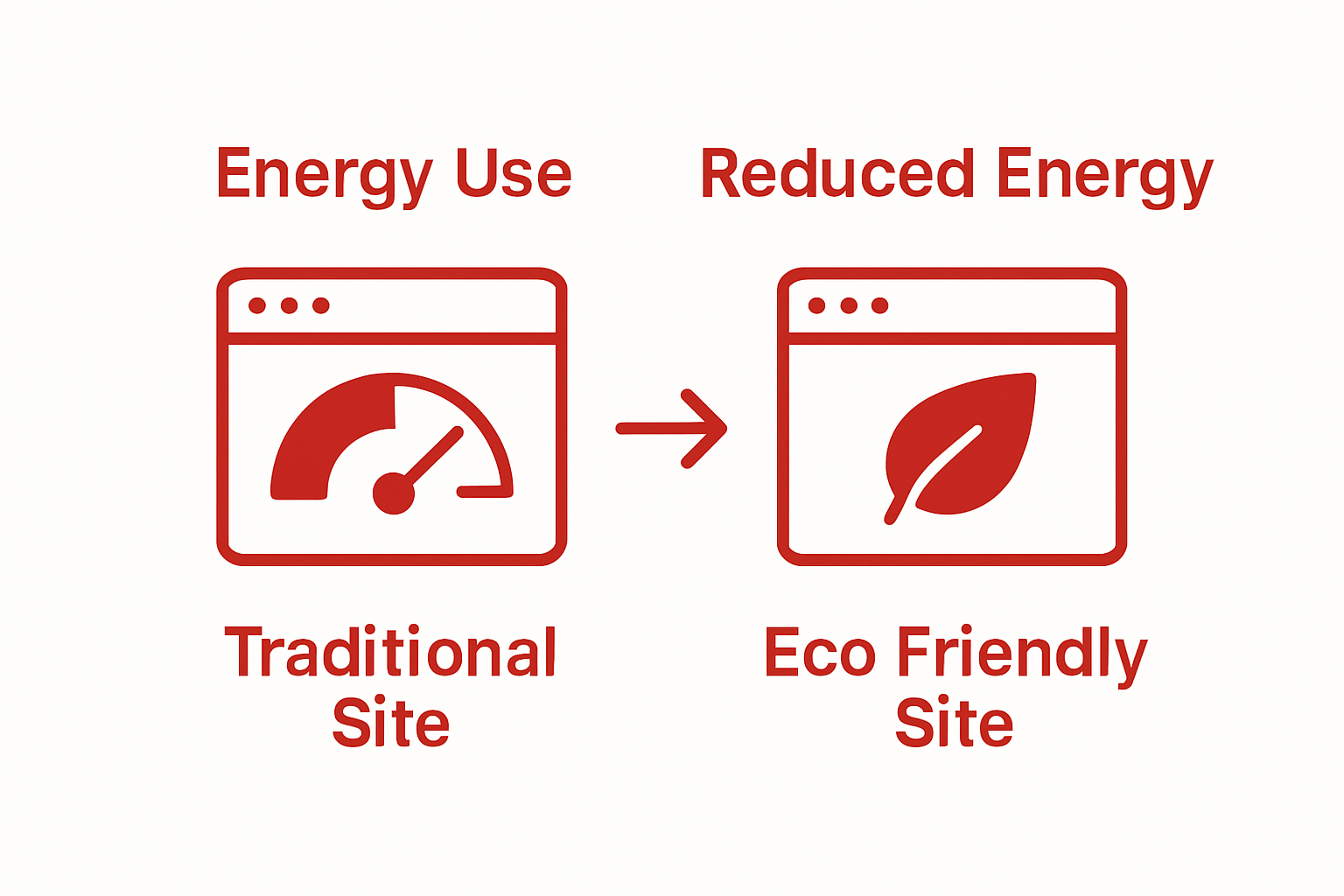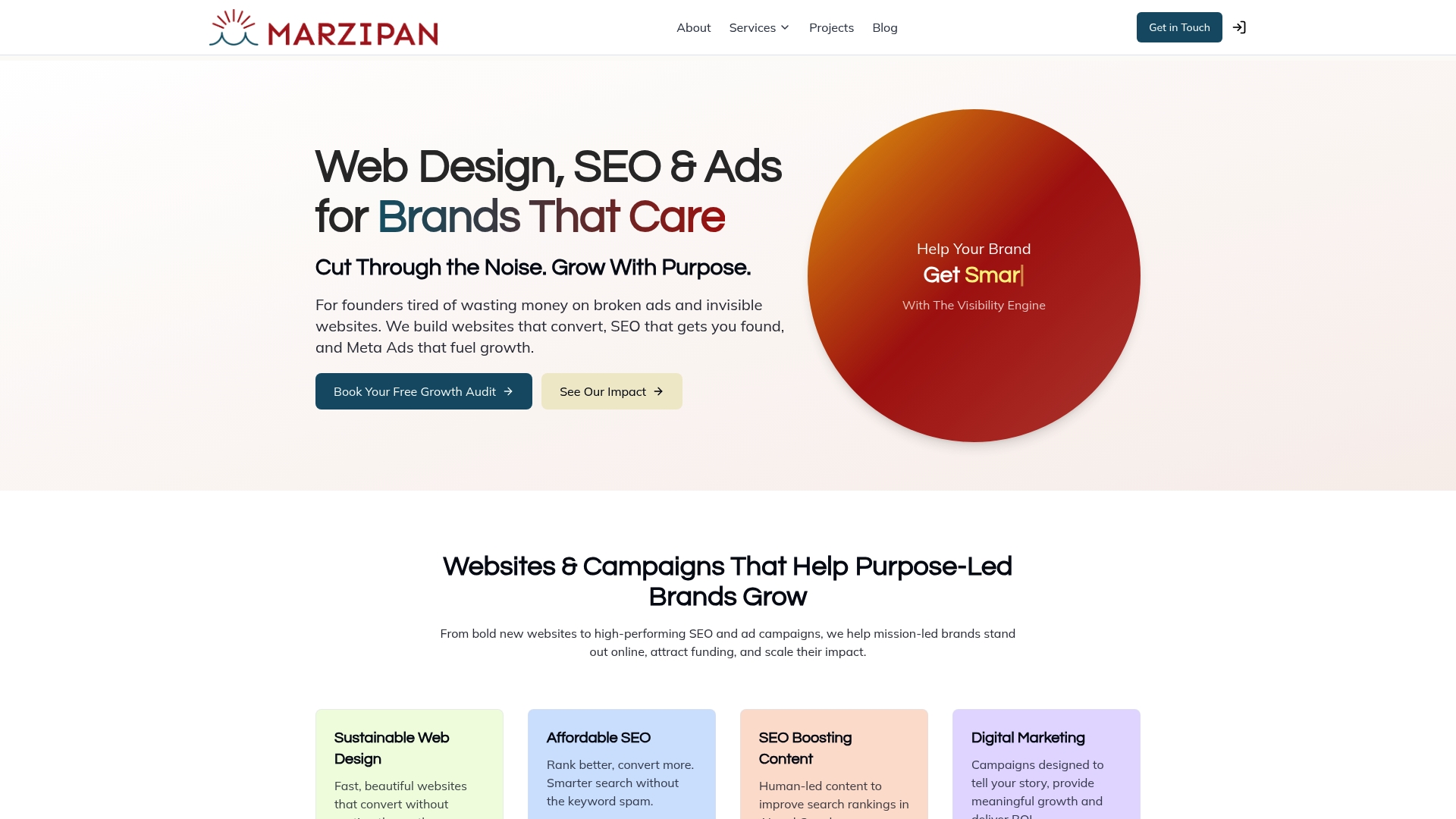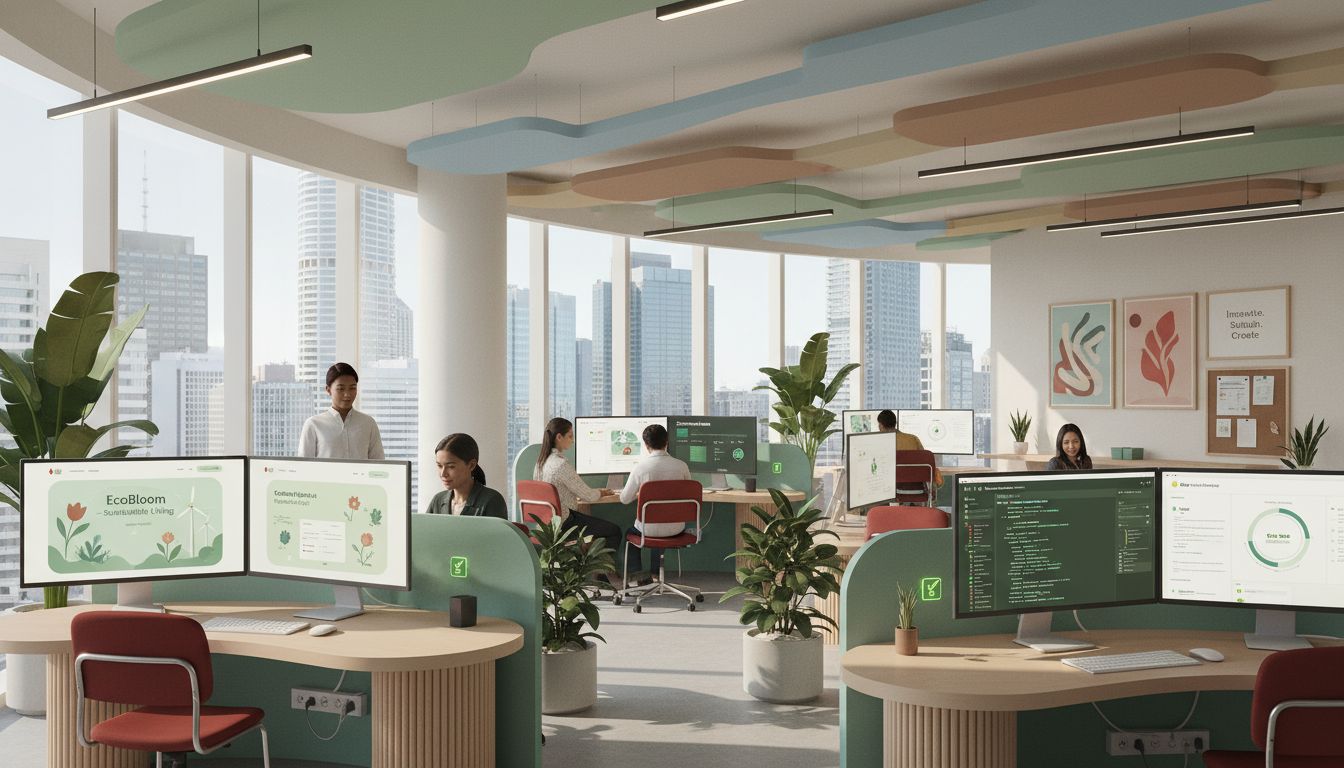Understanding the Benefits of Eco Friendly Sites
Eco friendly sites are reshaping how we think about building and using the web. Most websites feel invisible in terms of environmental impact, yet digital infrastructure now accounts for a significant share of global carbon emissions. You might expect the focus to be all glossy graphics or cutting-edge code, but the real revolution is how these sites quietly save energy behind the scenes, showing technology can help heal the planet while still delivering the online experiences we love.
Table of Contents
- What Are Eco Friendly Sites?
- Why Do Eco Friendly Sites Matter?
- How Eco Friendly Sites Contribute To Sustainability
- Key Concepts Behind Eco Friendly Site Design
- Real-World Examples Of Eco Friendly Sites In Sydney
Quick Summary
| Takeaway | Explanation |
|---|---|
| Focus on energy efficiency in design | Prioritising optimised website code and lightweight graphics reduces overall energy consumption significantly. |
| Choose sustainable web hosting | Use providers powered by renewable energy to minimise carbon emissions associated with hosting services. |
| Minimise data transfer and server load | Intelligent design that reduces unnecessary data transfer ensures lower energy use and a smaller carbon footprint. |
| Enhance corporate responsibility | Sustainable web design appeals to eco-conscious consumers, improving brand reputation and attracting customers. |
| Promote awareness of digital impact | By showcasing their commitment, companies can inspire broader ecological responsibility across the industry. |
What are Eco Friendly Sites?
Eco friendly sites represent a revolutionary approach to digital infrastructure that prioritises environmental sustainability in web design and hosting. These websites are consciously created to minimise their carbon footprint and reduce negative environmental impact through strategic technological choices.
The Core Principles of Eco Friendly Web Design
At their foundation, eco friendly sites focus on reducing energy consumption and computational resources required to serve web content. This involves multiple strategic approaches:
- Optimising website code for maximum efficiency
- Selecting green web hosting providers powered by renewable energy
- Minimising data transfer and server load through intelligent design
- Implementing lightweight graphics and compressed media files
The primary goal is creating digital platforms that deliver exceptional user experience while maintaining minimal environmental strain.
To highlight the core principles of eco friendly web design, the following table organises each principle alongside its specific sustainable outcome.
| Core Principle | Sustainable Outcome |
|---|---|
| Optimising website code for efficiency | Reduces energy required to load and operate websites |
| Using green web hosting powered by renewables | Minimises carbon emissions from web hosting |
| Minimising data transfer and server load | Decreases overall energy use and environmental impact |
| Implementing lightweight graphics and media files | Lowers computational resources used during browsing |
| Sustainable web design in Sydney represents a cutting-edge approach to achieving these objectives. |
Environmental Impact of Digital Infrastructure
According to research from the Department of Climate Change, digital infrastructure contributes significantly to global carbon emissions. Traditional websites consume substantial electricity through data centres, network infrastructure, and end-user devices. Eco friendly sites challenge this paradigm by reducing energy consumption and promoting more sustainable digital practices.
By implementing intelligent design principles, these websites demonstrate that technological innovation and environmental responsibility can coexist harmoniously.
They represent a critical step towards building a more sustainable digital ecosystem that respects planetary boundaries while delivering robust online experiences.
Why Do Eco Friendly Sites Matter?
Eco friendly sites are not merely a technological trend but a critical response to the growing environmental challenges posed by digital infrastructure. Their significance extends far beyond simple website design, representing a profound commitment to sustainable digital practices that can substantially reduce global carbon emissions.
Environmental Cost of Digital Infrastructure
Digital technologies consume significant energy resources.
 Research from the NSW Government’s Sustainability Advantage program reveals that traditional web infrastructure contributes substantially to carbon emissions. Every website visit, data transfer, and server interaction requires electricity, typically generated through non-renewable sources.
Research from the NSW Government’s Sustainability Advantage program reveals that traditional web infrastructure contributes substantially to carbon emissions. Every website visit, data transfer, and server interaction requires electricity, typically generated through non-renewable sources.
Key environmental implications include:
- Massive energy consumption by data centres worldwide
- Substantial carbon footprint from internet infrastructure
- Increasing digital waste and electronic resource depletion
- Continuous computational processing contributing to greenhouse gas emissions
Business and Societal Benefits
Beyond environmental considerations, eco friendly sites offer tangible benefits for businesses and society. Sustainable web design demonstrates corporate responsibility and appeals to environmentally conscious consumers. Check your website’s carbon impact to understand your digital environmental footprint.
Companies adopting eco friendly digital strategies can:
- Reduce operational energy costs
- Enhance brand reputation
- Attract environmentally aware customers
- Contribute to global sustainability goals
By prioritising eco friendly web design, organisations can play a meaningful role in mitigating climate change while maintaining technological excellence and user experience.

How Eco Friendly Sites Contribute to Sustainability
Eco friendly sites play a transformative role in promoting digital sustainability by implementing strategic technological practices that minimise environmental impact and drive positive ecological change. These digital platforms represent more than technological solutions they are active contributors to global environmental preservation efforts.
Reducing Carbon Footprint Through Digital Efficiency
Digital infrastructure generates substantial carbon emissions, making efficient web design crucial for environmental sustainability. According to the Australian Government’s Circular Economy initiative, reducing computational resources and energy consumption is fundamental to mitigating climate change.
Key strategies for reducing digital carbon footprint include:
- Implementing lightweight, optimised website code
- Utilising renewable energy powered web hosting
- Minimising unnecessary data transfers
- Designing energy-efficient server infrastructure
Promoting Sustainable Digital Practices
Eco friendly sites serve as practical demonstrations of environmental responsibility in the digital realm. By adopting sustainable web design principles, organisations can inspire broader industry transformation. Explore our sustainability insights to understand the broader implications of digital environmental stewardship.
These websites contribute to sustainability by:
- Encouraging responsible digital consumption
- Demonstrating technological innovation aligned with ecological principles
- Reducing overall energy demand in digital infrastructure
- Creating awareness about digital environmental impact
Through intelligent design and conscientious technological choices, eco friendly sites prove that digital innovation and environmental preservation can coexist harmoniously, paving the way for a more sustainable technological future.
Key Concepts Behind Eco Friendly Site Design
Eco friendly site design represents a sophisticated approach to digital infrastructure that integrates technological efficiency with environmental consciousness. This holistic methodology goes beyond traditional web development, embedding sustainability principles at the core of digital platform creation.
Foundational Design Principles
Sustainable web design prioritises resource efficiency and minimises environmental impact through intelligent architectural choices. Research from the Australian Department of Climate Change highlights the importance of creating digital platforms that are inherently designed for minimal ecological disruption.
Critical foundational principles include:
- Optimising code for maximum computational efficiency
- Reducing unnecessary data transfer and storage
- Selecting energy-efficient hosting solutions
- Implementing lightweight, streamlined design architectures
Technical Strategies for Sustainability
Implementing eco friendly site design requires a multifaceted approach that addresses both visible and invisible aspects of digital infrastructure. Web developers must consider computational resources, energy consumption, and long-term environmental implications in every design decision.
Key technical strategies encompass:
- Minimising image and media file sizes
- Using green web hosting providers
- Implementing advanced caching mechanisms
- Designing responsive interfaces that consume minimal resources
By integrating these sophisticated design concepts, web developers can create digital platforms that are not just functionally superior but also environmentally responsible.
The following table clarifies the key foundational design principles and technical strategies behind eco friendly site design, offering an at-a-glance view of each category and its implementation focus.
| Category | Principle or Strategy | Focus of Implementation |
|---|---|---|
| Foundational Principle | Optimising code efficiency | Reduce computational resource usage |
| Foundational Principle | Minimising unnecessary data transfer/storage | Lower bandwidth and energy consumption |
| Foundational Principle | Selecting energy-efficient hosting | Limit server energy requirements |
| Technical Strategy | Minimising image and media file sizes | Decrease resource load and power use |
| Technical Strategy | Using renewable energy hosting | Source server power from low-carbon sources |
| Technical Strategy | Implementing advanced caching mechanisms | Reduce server interactions for common content |
| Technical Strategy | Designing responsive, resource-light interfaces | Enhance efficiency across devices |
| Explore sustainable web development approaches to understand the deeper potential of eco-conscious digital design. |
Real-world Examples of Eco Friendly Sites in Sydney
Sydney stands at the forefront of digital sustainability, with numerous organisations implementing innovative eco friendly web design strategies that demonstrate environmental commitment and technological sophistication. These local examples showcase how digital platforms can reduce carbon footprint while delivering exceptional user experiences.
Sustainable Corporate Web Platforms
Corporate websites increasingly prioritise environmental responsibility through intelligent design choices. Research from the NSW Sustainability Advantage program highlights how organisations can leverage digital infrastructure to reduce ecological impact.
Standout characteristics of Sydney-based sustainable corporate websites include:
- Utilising renewable energy web hosting
- Implementing carbon-neutral digital strategies
- Developing lightweight, efficient website architectures
- Transparently reporting digital environmental performance
Environmental Sector Digital Innovations
Non-profit and environmental organisations in Sydney are leading the charge in eco friendly web design, creating digital platforms that not only communicate their mission but also embody sustainable technological principles. Explore our sustainable web design case studies to understand the practical implementation of these innovative approaches.
Key examples of sustainable digital platforms demonstrate:
- Minimalist design reducing computational resources
- Energy-efficient content delivery networks
- Interactive features promoting environmental awareness
- Transparent carbon footprint reporting
These real-world examples illustrate how Sydney-based organisations are transforming digital infrastructure into a powerful tool for environmental sustainability, proving that technological excellence and ecological responsibility can coexist harmoniously.
Ready to Transform Your Online Presence with Sustainable Web Design?
Is your business struggling with the hidden costs of traditional digital infrastructure? The article highlighted how eco friendly sites can tackle excessive energy consumption and massive carbon footprints. If you are aiming for a website that is not only efficient but also genuinely sustainable, now is the time to act. Discover how our expert team at Marzipan crafts lightweight, efficient digital solutions tailored for mission led businesses. We use intelligent, eco conscious web design strategies that match your commitment to the environment and provide a stronger foundation for growth.

Do not let your website fall behind in this new era of responsibility. Explore how you can turn your platform into a model of sustainability. Visit our sustainable web design services or read more about our latest sustainability insights. Start reducing your organisation’s digital carbon footprint today with Marzipan guiding each step.
Frequently Asked Questions
What are eco friendly sites?
Eco friendly sites are digital platforms designed to prioritise environmental sustainability by minimising their carbon footprint and reducing energy consumption through strategic web design and hosting choices.
Why are eco friendly sites important for the environment?
These sites significantly reduce the carbon emissions associated with digital infrastructure, helping to combat climate change and promote sustainability through responsible energy use and resource efficiency.
How can businesses benefit from adopting eco friendly web design?
Businesses can enhance their brand reputation, attract environmentally conscious customers, reduce operational energy costs, and demonstrate corporate responsibility by implementing sustainable web practices.
What are key strategies for creating eco friendly websites?
Key strategies include optimising website code for efficiency, using renewable energy powered hosting, minimising data transfers, and designing lightweight graphics and media files.
Recommended
- Sustainable Web Design Sydney | The Visibility Accelerator | Eco-Friendly Web Development | Marzipan Media
- Website Carbon Footprint Checker | Marzipan | Marzipan Media
- Digital Marketing Resources & Ebooks | Marzipan Media
- Sustainability Articles | Marzipan Media
- Environmentally Friendly Window Treatments: A 2025 Guide for UK Homes | Shutter World
- La Verne Community Initiatives for Sustainability You Need To Know







